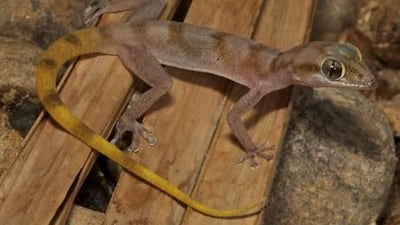FUJAIRAH // Scientists have discovered 25 new species of animals in a protected area of Fujairah's Hajar Mountains.
They are among 55 species that have until recently never before been seen in the Wadi Wuraya area.
Among the newcomers are the tiny, long-legged ant Lepisiota elegantissima, and a beetle, Sphenoptera vanharteni, which feeds on rotting vegetation.
The ant, which measures a mere 2mm, was discovered in one of the scores of branches of Wadi Wuraya.
"The ant has very long legs and I suspect it must be very agile and a high-speed runner at the scale of an ant," says Christophe Tourenq, the senior conservation manager at Emirates Wildlife Society - World Wide Fund for Nature (EWS-WWF).
"These are new species and scientists are still to learn about their lifestyle and habits. So far we are in the phase of trying to finish the description of biodiversity in the wadi but it is a never-ending story.
"Hopefully once we are done with this we can invite specialists to study in detail the new creatures. The more we know about them the better we can preserve them."
EWS-WWF collaborated with Fujairah Municipality in mapping the wadi's biodiversity.
Research there has been going on since 2006 and was managed by the Dutch scientist Antonius van Harten.
Mr van Harten's findings have been published in a four-book series, Arthropod Fauna of the UAE, summarising his discoveries in Wadi Wuraya and other parts of the country.
More than 250 specialists worldwide assisted him with the description and classification of the finds.
Mr Tourenq says while the new species are so tiny they are only likely to be noticed by experts, the discoveries are very significant.
"These creatures are part of the web of life," he says. "This beetle might be insignificant for you but it main be a main source of food for a bird species or the main predator of certain parasites. All species are connected."
The new species also include several beetles, spiders and terrestrial crustaceans.
Among those previously only found in other regions is Gallagher's leaf-toed gecko, or Asaccus gallagheri.
The tiny lizard was found in Fujairah in June by Dr Theodore Papenfuss, a researcher from the University of California, Berkeley, and his assistant Todd Pierson.
It is active at night when it uses its powerful vision to feed on insects and was first recorded in Masafi in the 1970s. But its presence at Wadi Wuraya was only confirmed this year.
The findings confirm the wadi as having one of the country's richest biodiversities. Scientists have recorded 74 families of invertebrates and 18 of reptiles and amphibians.
That is in addition to 74 species of birds, 12 species of mammals and about 300 species of plants.
Those plants become the focus of the programme this winter.

